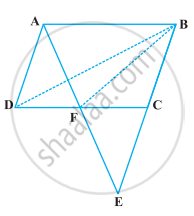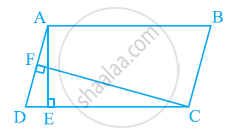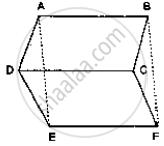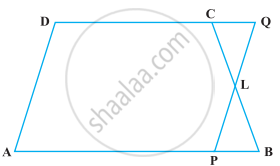Advertisements
Advertisements
Question
ABCD is a parallelogram in which BC is produced to E such that CE = BC (Figure). AE intersects CD at F. If ar (DFB) = 3 cm2, find the area of the parallelogram ABCD.
Solution
Given: ABCD is a parallelogram in which BC is produced to E such that CE = BC. C is the mid-point BE and ar (ΔDFB) = 3 cm2.
In triangle, ADF and triangle EFC,
∠DAF = ∠CEF ...[Alternate interior angle]
AD = CE ...[AD = BC = CE]
∠ADF = ∠FCE ...[Alternate interior angle]
So, ΔADF ≅ ΔECF ...[By SAS rule of congruence]
Now, ΔADF ≅ ΔECF ...[By SAS rule of congruence]
DF = CF ...[CPCT]
As BF is the median of triangle BCD.
ar (ΔBDF) = `1/2` ar (BCD) ...(i) [Median divides a triangle into two triangle of equal area]
As we know that a triangle and parallelogram are on the same base and between the same parallels then area of the triangles is equal to half the area of the parallelogram.
ar (ΔBCD) = `1/2` ar (ABCD) ...(ii)
ar (ΔBDF) = `1/2 {1/2 "ar (ABCD)"}` ...[By equation (i)]
3 cm2 = `1/4` ar (ABCD)
ar (ABCD) = 12 cm2
Hence, the area of the parallelogram is 12 cm2.
APPEARS IN
RELATED QUESTIONS
In the given figure, ABCD is parallelogram, AE ⊥ DC and CF ⊥ AD. If AB = 16 cm, AE = 8 cm and CF = 10 cm, find AD.

A farmer was having a field in the form of a parallelogram PQRS. She took any point A on RS and joined it to points P and Q. In how many parts the field is divided? What are the shapes of these parts? The farmer wants to sow wheat and pulses in equal portions of the field separately. How should she do it?
In the given below fig. ABCD, ABFE and CDEF are parallelograms. Prove that ar (ΔADE)
= ar (ΔBCF)

ABCD is a parallelogram, G is the point on AB such that AG = 2 GB, E is a point of DC
such that CE = 2DE and F is the point of BC such that BF = 2FC. Prove that:
(1) ar ( ADEG) = ar (GBCD)
(2) ar (ΔEGB) = `1/6` ar (ABCD)
(3) ar (ΔEFC) = `1/2` ar (ΔEBF)
(4) ar (ΔEBG) = ar (ΔEFC)
(5)ΔFind what portion of the area of parallelogram is the area of EFG.
In the below fig. ABCD and AEFD are two parallelograms. Prove that
(1) PE = FQ
(2) ar (Δ APE) : ar (ΔPFA) = ar Δ(QFD) : ar (Δ PFD)
(3) ar (ΔPEA) = ar (ΔQFD)
In which of the following figures, you find two polygons on the same base and between the same parallels?
Two parallelograms are on equal bases and between the same parallels. The ratio of their areas is ______.
PQRS is a rectangle inscribed in a quadrant of a circle of radius 13 cm. A is any point on PQ. If PS = 5 cm, then ar (PAS) = 30 cm2.
In trapezium ABCD, AB || DC and L is the mid-point of BC. Through L, a line PQ || AD has been drawn which meets AB in P and DC produced in Q (Figure). Prove that ar (ABCD) = ar (APQD)

ABCD is a trapezium in which AB || DC, DC = 30 cm and AB = 50 cm. If X and Y are, respectively the mid-points of AD and BC, prove that ar (DCYX) = `7/9` ar (XYBA)
